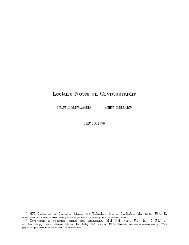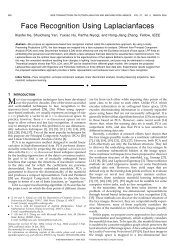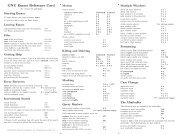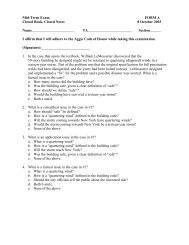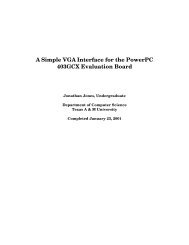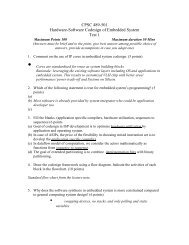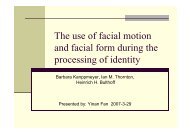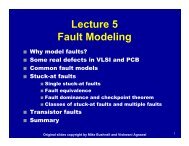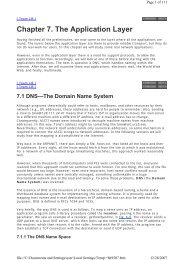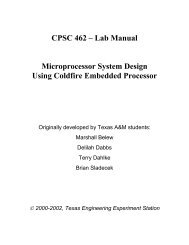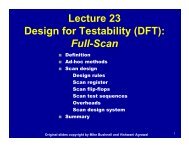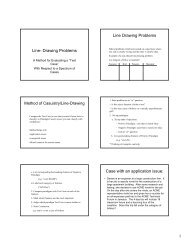Fall 2013 CSCE 666 Pattern Analysis Homework #1 Due date: 9/19 ...
Fall 2013 CSCE 666 Pattern Analysis Homework #1 Due date: 9/19 ...
Fall 2013 CSCE 666 Pattern Analysis Homework #1 Due date: 9/19 ...
You also want an ePaper? Increase the reach of your titles
YUMPU automatically turns print PDFs into web optimized ePapers that Google loves.
<strong>Fall</strong> <strong>2013</strong><br />
<strong>CSCE</strong> <strong>666</strong> <strong>Pattern</strong> <strong>Analysis</strong><br />
<strong>Homework</strong> <strong>#1</strong><br />
<strong>Due</strong> <strong>date</strong>: 9/<strong>19</strong>/<strong>2013</strong><br />
In recognition of the Texas A&M University policies of academic integrity, I certify that I have<br />
neither given nor received dishonest aid in this homework assignment.<br />
Name: _________________________<br />
Signature: ______________________<br />
PLEASE FOLLOW THESE GUIDELINES:<br />
1. Download the compressed file ‘hw1.zip’ from the course web page<br />
2. Start each problem on a separate page<br />
3. Provide hardcopies of all plots, MATLAB code and derivations<br />
4. Sign and return this page with your finished assignment.<br />
5. It is very important that you show your work and discuss your findings. This ensures<br />
full credit if your results are correct, and allows you to earn partial credit otherwise!<br />
Problem 1 (20%)<br />
(1) Given the set of patterns in Figure 1, which correspond to the vowels in the Korean alphabet,<br />
design a set of features (not more than 8) that provides good separability between all classes.<br />
Discuss your rationale.<br />
(2) Generate MATLAB code to extract these features for each pattern. Generate twodimensional<br />
scatter plots for each pair of features (e.g., f1 vs. f2, f3 vs. f4, etc). Discuss your<br />
results.<br />
(3) Compute the Euclidean distance between each pair of examples in the original space (i.e.,<br />
along 16,384 dimensions), and display it as a 50x50 matrix (HINT: use “imagesc”). Repeat the<br />
above, but in the low-dimensional space defined by your features. By comparing these two<br />
distance matrices, what can you tell about class separability in the original image space and in<br />
your final feature space? Discuss your results.<br />
Figure 1. Dataset of handwritten Korean vowels<br />
TAMU <strong>Fall</strong> <strong>2013</strong> <strong>CSCE</strong> <strong>666</strong> <strong>Homework</strong> <strong>#1</strong> 1/3
NOTES:<br />
• An electronic copy of these patterns can be loaded from the file “hw1p1_data.mat” (“load<br />
hw1p1_data”). Each example is a 1x16,384 row vector. You may use the command<br />
“reshape” to convert each example into a 128x128 image, and the command “imagesc” to<br />
display the image.<br />
• To generate scatter plots, use the command “text” and labels ‘0’ through ‘9’ for each of<br />
the ten classes. Use the command “axes” to adjust the range of the two axes.<br />
Problem 2 (20%)<br />
Assume that you are to build a probability density function of the produce from a California<br />
farm that grows two types of strawberries: maincrops and alpines. The maincrops are larger,<br />
with an average size of 12 grams and a standard deviation of 6 grams. The alpines are smaller,<br />
with an average size of 6 grams and a standard deviation of 1 gram. As an approximation,<br />
assume that the distributions are Gaussian. On an average season, the production of maincrops<br />
is three times as large as that of alpines (in number of fruits, not weight)<br />
(a)<br />
(b)<br />
(c)<br />
Generate a single pdf to model the distribution of weights regardless of strawberry<br />
size. Generate a plot of this theoretical density.<br />
Generate N=10,000 random samples according to this distribution. Generate a<br />
histogram of this sampled distribution using an appropriate number of bins.<br />
Do the theoretical and experimental distributions match? If so, why? If not, why not?<br />
HINT: Remember that the mass (area) of the histogram and the theoretical pdf have to be<br />
EACH equal to ONE.<br />
Problem 3 (20%)<br />
Consider a medical diagnosis problem where a fast biochemical test is used for screening<br />
patients. The test returns a result close to ZERO for healthy patients and close to ONE for<br />
infected patients, according to the following likelihood functions:<br />
p(x|ω 1 ) = N(μ = 0, σ = 0.3)<br />
p(x|ω 2 ) = N(μ = 1, σ = 0.1)<br />
Assuming that, on average, 1 out of 10,000 patients is infected, and the following misdiagnosis<br />
costs:<br />
• Diagnosing a healthy patient as “infected”: expected $20,000 in medical bills for a<br />
comprehensive in-patient procedure,<br />
• Diagnosing an infected patient as “healthy”: expected $1M settlement for medical<br />
malpractice,<br />
analytically determine a decision rule for each of these criteria:<br />
(a) Maximum Likelihood<br />
(b) Maximum A Posteriori<br />
(c) Minimum Bayes Risk<br />
Discuss your results.<br />
TAMU <strong>Fall</strong> <strong>2013</strong> <strong>CSCE</strong> <strong>666</strong> <strong>Homework</strong> <strong>#1</strong> 2/3
NOTE: You can use the MATLAB “solve” command to find the symbolic roots of polynomials.<br />
You can convert symbolic expressions into numeric values with the command “subs”.<br />
DISCLAIMER: This problem is not intended to reflect decision-making practices in the<br />
healthcare industry.<br />
Problem 4 (20%)<br />
Consider a two-class univariate classification problem with equal priors and the following<br />
likelihood densities:<br />
p(x| ω 1 ) = N(0,2); p(x| ω 2 ) = N(4,2);<br />
(a)<br />
(b)<br />
(c)<br />
(d)<br />
(e)<br />
(f)<br />
(g)<br />
(h)<br />
(i)<br />
Determine the optimal decision rule for minimizing the probability of error.<br />
Determine the theoretical probability of error (HINT: You may solve numerically<br />
using numerical integration with “quad”, or analytically expressing the<br />
probability of error in terms of the error function “erf”).<br />
Generate a dataset of test examples (100 examples per class). Label each<br />
example according to the pdf from which it was drawn (its true label).<br />
Classify each example according to the decision rule derived in (a).<br />
Compare the predicted class label against the true class label of each example and<br />
estimate the correct classification rate of the decision rule.<br />
How does this classification rate compare with the probability of error in (b)?<br />
Repeat parts (c-f) for 1,000 test examples<br />
Repeat parts (c-f) for 1,000,000 test examples<br />
Discuss your results.<br />
Problem 5 (20%)<br />
Load dataset ‘hw1p5_data’, which contains synthetic data from a non-linear function y=f(x) + n,<br />
where n is additive noise. You are asked to investigate the extent to which polynomial functions<br />
can be used to model this relationship.<br />
(1) Randomly select n=10 data points as training data; the remaining data points will be<br />
used as test samples. Build a polynomial model of order 1 (e.g., y = ax+b) (HINT: use<br />
the command ‘polyfit’) Plot the output of the model (at the ‘test samples) vs. the test<br />
samples themselves. Compute the mean-squared-error (MSE) of the model (e.g., the<br />
average of the squared difference between model predictions and correct outputs).<br />
(2) Repeat part (1) for polynomials of order 2 through 10.<br />
(3) Repeat parts (1-2) 100 times, and estimate the MSE for each polynomial order as the<br />
average across its 100 repetitions. Generate a plot that shows the log-MSE (i.e., the MSE<br />
in logarithmic scale) versus the polynomial order.<br />
(4) Repeat parts (1)-(3) for training sets of sizes n={15, 20, 25, 50, 100, 200} Discuss how<br />
the log-MSE of the model changes as a function of (a) the polynomial order and (b) the<br />
number of samples used to train the model.<br />
(5) Discuss your results.<br />
TAMU <strong>Fall</strong> <strong>2013</strong> <strong>CSCE</strong> <strong>666</strong> <strong>Homework</strong> <strong>#1</strong> 3/3





